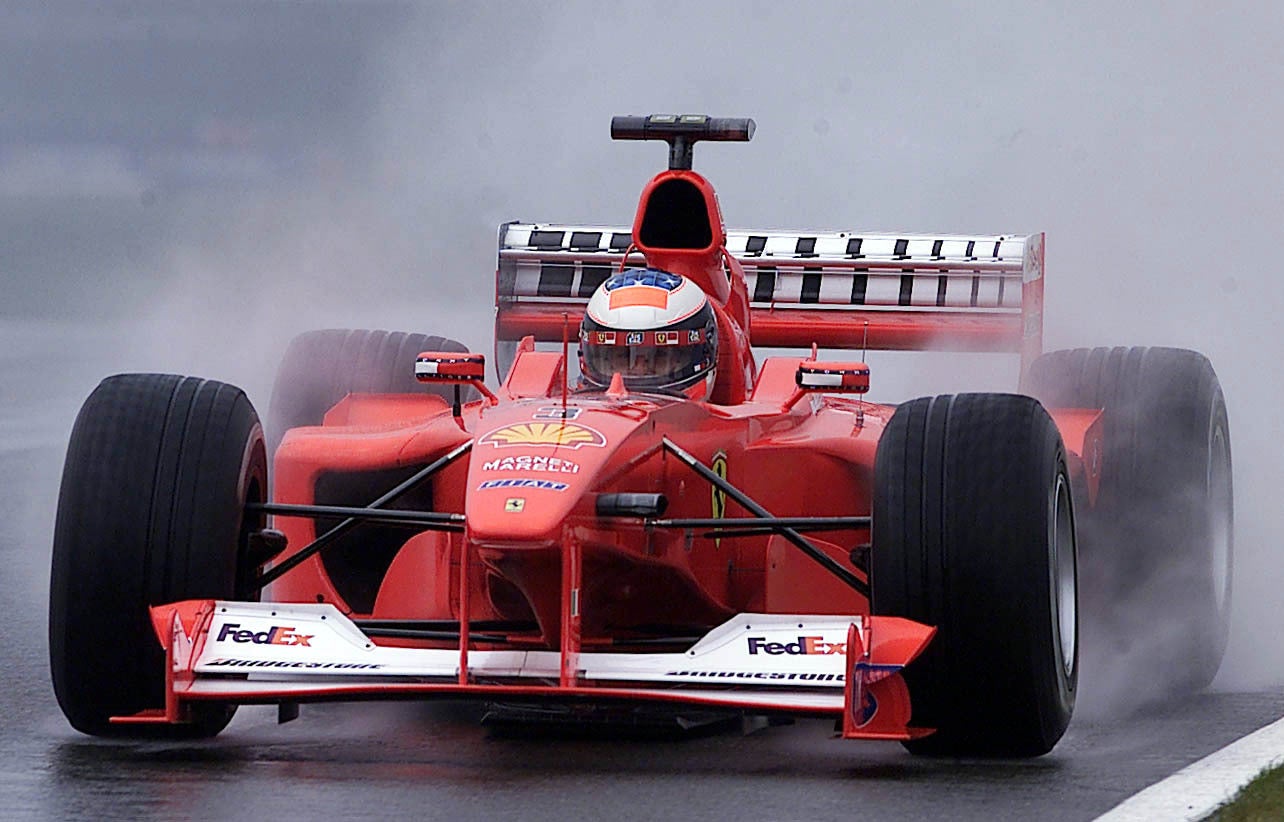Michael Schumacher: The seven-time world champion’s career in Formula One
New Netflix documentary recounts rise of superstar German driver and recovery from traumatic head injury sustained in skiing accident in 2013
Your support helps us to tell the story
From reproductive rights to climate change to Big Tech, The Independent is on the ground when the story is developing. Whether it's investigating the financials of Elon Musk's pro-Trump PAC or producing our latest documentary, 'The A Word', which shines a light on the American women fighting for reproductive rights, we know how important it is to parse out the facts from the messaging.
At such a critical moment in US history, we need reporters on the ground. Your donation allows us to keep sending journalists to speak to both sides of the story.
The Independent is trusted by Americans across the entire political spectrum. And unlike many other quality news outlets, we choose not to lock Americans out of our reporting and analysis with paywalls. We believe quality journalism should be available to everyone, paid for by those who can afford it.
Your support makes all the difference.Netflix’s new documentary Schumacher was released on Wednesday 15 September, 30 years to the day after Formula One icon Michael Schumacher made his debut at the 1991 Belgian Grand Prix.
The documentary follows the German driver’s journey from his father Rolf’s go-karting track in Hurth, North Rhine-Westphalia, to become one of motor sport’s most successful drivers, claiming 91 victories, 165 podium placings and seven world championships.
Supported by the Schumacher family in rare interviews and previously unreleased footage, the film promises to present a more intimate view of a driver often viewed as a relentless winning machine, also looking at the toll the ski accident he suffered on 29 December 2013 has taken on him and his loved ones as he continues his prolonged recovery from the serious head trauma he suffered that day.
As the new film shows, the serial champion wasn’t always such a safe pair of hands behind the wheel. He crashed his first motorised kart - built by his father - into a tree, but by the age of 18 he had already secured both the German and European kart championships. He was ready to step up a gear.
What followed was a remarkable and unrivalled career through Formula Ford, Formula Three, Sportscars and, most prominently, Formula One.
Schumacher retired for the second and final time in October 2012 and was the most successful man to ever grace the sport until Lewis Hamilton arrived on the scene to steal his crown. The German’s seven world championship wins - two with Benetton and five with Ferrari, a feat since equalled by Hamilton - had seen him overtake Juan Manuel Fangio’s record of five successes in 2002.
Schumacher could well have added an incredible eighth title to his name had he not suffered a terrifying crash at the British Grand Prix in 1999, when he suffered a broken leg while leading the driver’s championship. His absence saw McLaren’s Mika Hakkinen go on to claim a second successive title but the German made a quick recovery to return before the end of the season.
His comeback from injury duly saw him claim Ferrari’s first world title since 1979 and instantly find a place in the hearts of every Tifosi fan who so passionately supported him when he joined the marquee in 1996.
Having made an immediate impression on the F1 paddock as a young man, Schumacher first emerged as a genuine title contender in 1994, once the dominance of firstly McLaren and then Williams had ended. The third Grand Prix of that season though was one that would have a serious impact on both Schumacher himself and the sport as a whole.
F1 legend Ayrton Senna was leading the San Marino Grand Prix at Imola with Schumacher behind in hot pursuit when the Brazilian’s Williams went off at the Tambarello corner at high speed. Senna suffered fatal head injuries, although the race continued as the three-time world champion was air-lifted to hospital before he was later announced dead. The sport had already been shocked by the death of Roland Ratzenberger during qualifying the day before.
Following Schumacher’s success at the 2000 Italian Grand Prix at Monza, the German broke down in tears during a press conference when asked what matching Senna’s number of wins meant to him. For a man seen as the stereotypical “bad guy” of F1, it was a rare outpouring of emotion, at odds with his reputation for machine-like dominance behind the wheel. Schumacher has never spoken of that moment since.
Having won back-to-back titles in 1994 and 1995 (albeit in highly controversial circumstances after he clashed with Damon Hill), Schumacher switched to Ferrari in an attempt to revive the famous manufacturer and restore it to its former glory.
Alongside team principal Jean Todt and technical director Ross Brawn, who moved with Schumacher to Benetton, he competed with the Williams duo of Hill and Jacques Villeneuve for the 1996 and 1997 title but was ultimately unsuccessful.
The next two seasons brought a terrific battle with the McLaren pairing of Hakkinen and David Coulthard that saw the Finn claim the title back-to-back, with the German suffering his broken leg colliding with the barriers at Silverstone’s Stowe Corner.
His return after 98 days was the making of him, as he went on to secure his place in history by winning the next five world championships in a period of dominance for Ferrari the likes of which had never been seen before.
The 2003 season was a particular highlight for the Ferrari man as he had two young upstarts challenging him for the title - Kimi Raikkonen and Juan Pablo Montoya - with Schumacher taking the title by just two points over the former, who would later replace him following his first retirement.
After a two-year battle with then-Renault driver Fernando Alonso, Schumacher announced in an emotional radio message to his team that he would be stepping away at the end of the season. But there would be no fairy tale ending as Alonso clinched the championship ahead of him.

Now a regular on the pitwall, Schumacher was all set for a comeback when his former team mate and close friend Felipe Massa suffered a serious eye injury when a spring fell off Rubens Barichello’s Williams and struck his fellow Brazilian’s helmet, knocking Massa unconscious and sending him into the tyre wall during qualifying for the Hungarian Grand Prix in 2009.
But a bike crash earlier that year had left Schumacher himself with a concussion and a long-standing neck injury and he was deemed unfit to compete after taking part in a test session, with the woeful Luca Badoer and Giancarlo Fisichella standing in for Massa instead.
However, Schumacher did make a return with the Mercedes team a year later after Brawn GP were taken over by the German manufacturer. The comeback failed to live up to its billing, however, with a lone third-placed finish coming in the 2012 European Grand Prix on the streets of Valencia standing as Schumacher’s best finish in the three-year stint.
When Hamilton signed for Mercedes towards the close of that year, it signalled the end for the most successful driver the sport had ever seen up to that point.
His subsequent accident descending the Combe de Saulire below the Dent de Burgin above Meribel in the French Alps, which left him in a medically-induced coma for six months, has perhaps overshadowed his extraordinary legacy on the track in recent years, a wrong Netflix’s new documentary hopes to right.




Join our commenting forum
Join thought-provoking conversations, follow other Independent readers and see their replies
Comments